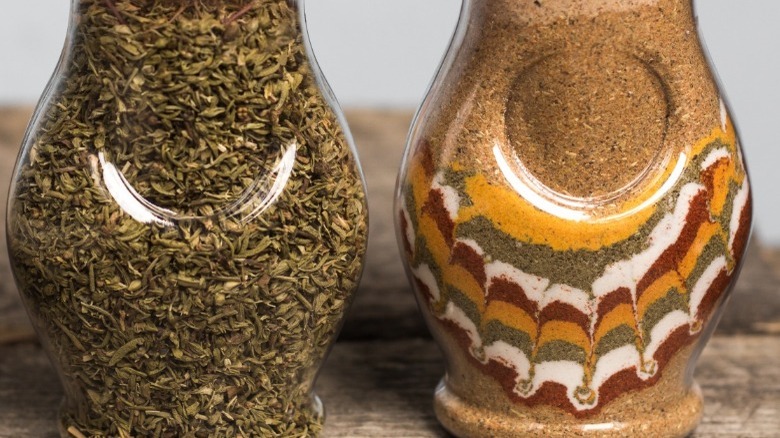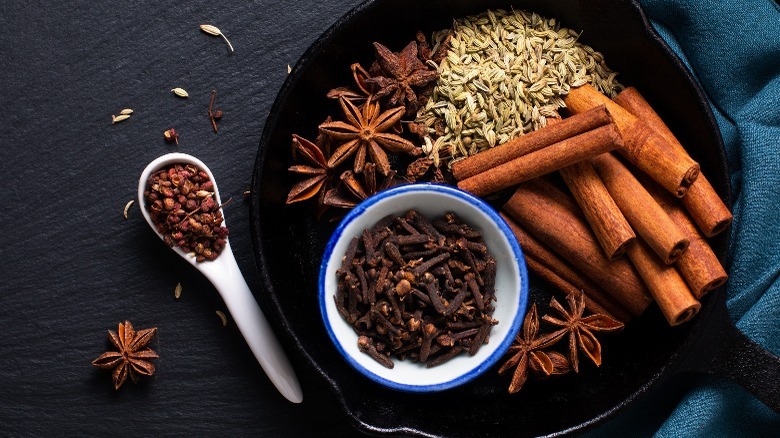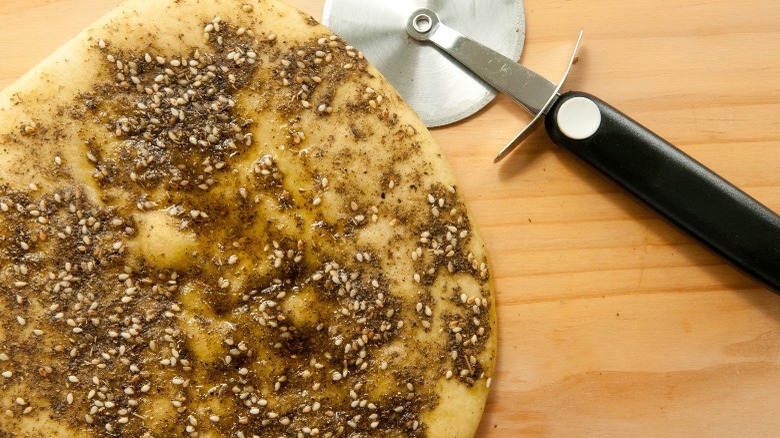14 Spice Blends From Around The World
Variety is the spice of life, and when it comes to spice blends, there's no shortage of variety. The potential combinations are limitless, and every culture has its own mixes to make the local dishes sing. Spice blends show just how versatile some kitchen ingredients really are. Take cinnamon, which is equally at home in a sweet pumpkin spice blend as it is in a fiery and savory Ethiopian berbere. Or cumin, which adds smoky notes to dishes across the Americas, Asia, and Africa.
Spices bring depth and nuance to flavor. They also have myriad health benefits (for example, cayenne can help prevent heart disease per Healthline, and turmeric can reduce inflammation). Combine spices into mixed blends and you're compounding flavor complexities and health benefits. Below are our favorite spice blends from around the world — what's in them, where they come from, why they're so beloved, and more. Read on to learn all about these flavor bombs so you can spice up your cooking game.
1. Tempero Baiano
Named for the Brazilian region Bahia, tempero Baiano balances various sources of heat with aromatic herbs. Piquant Post's version uses black and white peppercorns and red pepper flakes for the former, with marjoram, oregano, parsley, basil, and bay leaf constituting the latter. Cumin, nutmeg, and turmeric are also common flavors added.
The blend represents the melting pot of intercontinental influences in Bahia, from the indigenous people to Portuguese colonizers to enslaved Africans, according to the Brazilian blog Casa & Agro. A lot of Bahian cooking is reflective of the region's history as a center for the country's slave trade from 1558 until its abolishment in 1888 (per UNESCO).
Take, for instance, moqueca, a fish stew popular across Bahia and other coastal regions of Brazil (via Food and Road). The palm oil has African roots, the coconut milk is a nod to the country's tropical climate, the concept of a stew comes from traditional European methods for cooking vegetables, and fish is plentiful in the seaside Bahian capital city of Salvador. Finally, the tempero Baiano which seasons the dish to give it its signature flavor unites it all together.
2. Sharena sol
Sharena is Bulgarian for colorful and sol means salt, so as you can imagine, this seasoning is quite vibrant. Paprika is the spice of choice and it gives sharena sol its signature red hue. In addition to salt, it also contains any number of dried herbs, such as thyme, fenugreek, or basil (each included in the Home Cook's Pantry version). The most critical herb, however — in sharena sol but perhaps in Bulgarian cooking in general — is chubritsa, the country's summer savory.
Chubritsa, according to the shop Bulgarian Spices, is similar to thyme but with a much more distinctive aroma. Balkan cuisine uses savory to aid in digestion, so it is commonly paired with foods that can be tough on the stomach, such as lentils and beans. Sharena sol is primarily featured as a table blend, and instead of being cooked into dishes it replaces salt and pepper shakers, as explained in "The Kitchen Herb Garden."
3. Merkén
The country of Chile is not necessarily named after the spicy ingredient prevalent in many Latin American cuisines, but rather, one theory suggests, from the indigenous Mapuche word for "deepest point of the earth" (per New World Encyclopedia). That said, chile peppers still play an important role in many Chilean dishes and ingredients, including merkén. The spice blend comes from the Araucanía region of the country, which was originally inhabited by the Mapuche people until the Spanish conquest. According to Amnesty International, conflicts between the native communities and the Chilean government continue to this day, but their contributions have influenced the country's agriculture, cuisine, exports, and more.
The starring ingredient in merkén is the cacho de cabra (goat's horn) chile, named for its shape. The chile is dried, smoked, ground, and then mixed with coriander, cumin, and salt. It can be used as a table seasoning or a dry rub to add a smoky note to dishes. Two classic applications, according to Eccentric Culinary, are puré picante (mashed potatoes with merkén) and mani merkén (spicy roasted peanuts).
4. Five spice
Five spice is a deliciously balanced quintet of star anise, fennel seed, cinnamon, clove, and Szechuan peppercorn. The first two contribute an earthy, licorice-like flavor, while cinnamon and clove amplify sweet notes in dishes. The last creates the flavor sensation known as mala, which numbs the palate. Five spice works particularly well with fatty meats like pork but can also be used as a warming element in baked goods. In fact, at least two of the five components — cinnamon and clove — are regularly found in pumpkin pie spice.
While five spice's exact culinary origins are disputed, Chinese American cooking blog The Woks of Life notes that the number five is significant both in cooking and traditional Chinese medicine. Chinese cuisine focuses on the balance of sweet, sour, pungent, bitter, and salty (each present in the blend), while the equal alignment of the elements earth, fire, water, metal, and wood signifies a healthy qi, or life force.
5. Berbere
As Ethiopia's prized chicken stew doro wat hits the plate (or more traditionally, a large piece of sourdough flatbread, aka injera, acting as a plate), what first reaches your nose is a fragrance that's somehow simultaneously fierce and comforting, like a hug from a prizefighter. That smell is berbere, the vibrant red mix used in many Ethiopian dishes, from meaty stews to vegetable purees. The name, according to The Spruce Eats, comes from the Amharic (one of Ethiopia's five official languages, as per Ventures Africa) word barber, meaning pepper.
Exact ingredients vary and families and vendors have their own unique blends. Ethiopian-Swedish American chef Marcus Samuelsson's version uses chiles de árbol for heat, various aromatics like coriander, fenugreek, garlic, and onion, as well as a litany of warming spices including cardamom, cinnamon, ginger, nutmeg, and allspice. And it's not just for stews, either.
According to Tasting Table, Samuelsson is known to sprinkle berbere over any course at any time of the day. Among his favorite applications: sprinkled over ricotta and avocado toast, mixed into a poke bowl, and paired with chopped pineapple and fermented honey. Fermented honey is not dissimilar from tej, Ethiopia's honey wine, which can be mixed with berbere to create the dipping sauce awaze, per Spices, Inc.
6. Herbes de Provence
You probably don't need to spend much time on DuoLingo to figure out what this one means: herbs from Provence (a region in France). As the name implies, this is technically an herb blend and not a spice blend, but it still deserves a place in the pantry.
Herbes de Provence typically contains what you'd find growing in Provençal gardens in summer months: savory, marjoram, rosemary, thyme, oregano, tarragon, and bay leaf (per MasterClass). The blend has been a signature of the region's cuisine for some time, but it didn't become a definitive term or take off commercially until Julia Child popularized it in her 1961 tome "Mastering the Art of French Cooking." Herbes de Provence appears in her sautéed chicken recipe, but it's also a common addition to red meat, fish, and vegetables, and can be whisked into dressings and sauces.
You may find that many versions sold in the US also contain lavender. Though this floral fragrance permeates the countryside in Provence, it is not a part of the traditional blend. Spicewalla suggests that its usage is more of a tourism-driven decision, given lavender's regional prevalence.
7. Garam masala
Masala is a Hindi catchall term for a spice blend. You have chai masala, chaat masala, tandoori masala ... the list goes on. One of the most widely used masalas is garam masala. Garam essentially translates to hot, but think of it more as a warm heat rather than a spicy one. The blend adds an earthy depth of flavors without revving up the Scoville units. In turn, the warmth of the spices warms the body by increasing metabolism, according to NPR.
There's no definitive recipe for garam masala, but just about all versions will include cumin, coriander, cardamom (both the citrusy green variety and the more savory black), clove, and star anise. For the most flavor, it's best to toast these spices whole before grinding them into a fresh powder. In some dishes such as fragrant biryani rice, the spices remain whole (via Indian Kitchen and Spices). Once they're tempered in oil or ghee, the spices release their aromatic oils, perfuming the dish rather than overpowering all the other flavors.
8. Jerk seasoning
There are wet and dry varieties of this Caribbean favorite, used as either a marinade or dry rub, respectively. Either way, among the key components are allspice (dried berries from the Pimenta dioica tree) and Scotch bonnet peppers (anywhere from 12 to 140 times hotter than a jalapeño, according to Chili Pepper Madness), plus thyme, garlic, and scallion. While jerk seasoning is widely used to refer to this particular collection of flavors, the term jerk comes from the Quechuan word charqui, meaning dried strips of meat, according to Taste Atlas. Now, jerk refers to a method of cooking in which meat is smoked in an underground pit over a long period of time.
But jerk is not just a flavor and it's not just a cooking method; it's a product of liberation and survival. The process of jerk cooking was passed from the native Taíno community to Maroon colonies of freed or escaped slaves. The spices used in jerk allowed the meat to be preserved. Additionally, the meat was cooked underground to avoid producing smoke, which would reveal the escapees' whereabouts to plantation owners, Smithsonian Magazine explains. This is why chef Gariel Ferguson calls jerk "freedom manifested in food."
9. Shichimi togarashi
Whenever you dine at a ramen shop, you're likely to find a small container of this fiery red mix with black and white flecks not far from reach. You may think this is some sort of ground pepper, but if that tableside condiment is actually shichimi togarashi, you're only partly correct. The finishing blend translates to seven tastes, some of which correspond to heat.
The spice factor comes from the togarashi (a specific type of red chile) itself. Sansho, a peppercorn similar to Sezchuan, also helps to up the spice ante. Rounding out the remaining five tastes, according to The South China Morning Post, are seaweed for umami, white and black sesame seeds for texture, ginger for aromatics, and citrus peel for brightness. According to Japanese Food Guide, shichimi togarashi is a great addition to all sorts of noodle dishes, sprinkled over yakitori, or stirred into miso soup.
10. Ras el hanout
Within the labyrinthine alleys of Morocco's many souks (markets), you'll find sections devoted entirely to spices, such as the famous Place des Épices in Marrakech. Vendors lure passersby with their impressive displays of ground spices in all hues, arranged neatly in tall, conical piles. No matter which shop you enter, you're bound to find Morocco's most famous blend: ras el hanout.
What's in it? As implied by the Arabic translation meaning head of the shop, it depends on who you get it from. Some mixes can have as many as 40 different spices, according to Taste of Maroc, however, among the most common inclusions are cinnamon, turmeric, ginger, cardamom, clove, and cumin.
Moroccan cuisine is not driven by heat so much as it is by spice and warmth, and ras el hanout tends to contain some floral notes (sometimes from rosebuds or lavender). Sweetness is a flavor profile not just reserved for desserts — you'll find dried fruit in tagines (savory stews) and per Taste Atlas, you'll find powdered sugar dusting the tops of pastilla (flaky meat pies) — which makes the sweet and savory blend a perfect seasoning for Moroccan food.
11. Sazón
Translated from Spanish it means seasoning, and indeed sazón is a staple in the kitchens of many Latin American home cooks and professional chefs. Illyanna Maisonet, author of the Puerto Rican cookbook "Diasporican," says the blend "creates the flavor and the color that most can easily identify as Puerto Rican food" (via The Today Show.) Among those flavors are cumin, garlic, and oregano. The distinct blood-orange hue is courtesy of achiote, a powder made from crushed annatto seeds.
Sazón can be cooked into rice (such as in Mashed's arroz con pollo recipe), beans, soups, and more. It also makes for a killer spice rub, particularly for pork. Once it's slathered on pork shoulder in Rick Martinez's recipe for pernil (via Bon Appétit), the meat absorbs the flavors for up to three days before hitting the oven.
One of the most widely available brands of sazón is from Goya. The company produces versions with or without salt, with saffron, without achiote, and more. There are smaller-batch brands out there as well, such as Loisa, which promises a "more honest taste."
12. Za'atar
Za'atar is the name of an herb made from leaves from the eponymous shrub, present across the Levant (Israel, Palestine, Syria, Lebanon, etc.). But the za'atar we're referring to is actually a common mixture that, confusingly, contains za'atar the herb. According to Yotam Ottolenghi in his column for The Guardian, good za'atar should combine the dried herb with sesame seeds, sumac, salt, and nothing else. However, some za'atar blends such as the one featured on Feasting at Home, swap out the namesake herb for thyme or oregano.
The herbs each add their own earthy aromas and sesame seeds provide a nutty crunch to the blend. Meanwhile, sumac — made by drying and coarsely grinding the deep red berries of a Mediterranean shrub — contains an unexpected acidity. Think of it as a light squeeze of lemon, but with a little crunch.
Once all the za'atar ingredients are combined, the blend can be used to season roast meats or simply sprinkled onto dips or salads. It is also commonly incorporated in baking, according to The Kitchn. In Lebanon, it's not uncommon for women to bring their own za'atar blend to the local baker who prepares manouche, a type of flatbread. The za'atar gets pressed into the surface of the dough before it bakes, yielding a flavorful crust.
13. Harissa
Harissa is a popular condiment across North Africa and the Middle East. The name is derived from the Arabic word harasa meaning to pound, referring to the method in which chiles and other ingredients are pulverized into a paste (via Belazu). While the spreadable kind is the most common form, harissa can also be found as a powdered spice blend. Either way, like hot sauce it can range from mild and fragrant to unapologetically spicy.
The basic recipe, according to NPR, includes chiles, garlic, olive oil, coriander, and one ingredient that sets it apart from all other fiery blends: caraway seeds. Caraway is a key component in rye bread, but it is actually native to Northern Africa and is sometimes referred to as Persian cumin.
One popular variation incorporates floral notes by way of rose petals. Rose harissa is one of Yotam Ottolenghi's essential ingredients in many of his cookbooks, including "Flavor" and "Simple." Adding rose water and dried rose petals offers an unexpected counterpoint to the smokiness of the blend.
14. Pumpkin Pie Spice
Oh, pumpkin pie spice: the Ugg boots of the spice rack. It's warm, it's cozy, and it has a reputation for being basic. But no matter what the haters say (celebrity chefs included), pumpkin pie spice is more than a trend; it is the definitive taste of fall. The mix of cinnamon, nutmeg, ginger, clove, allspice, and cardamom helps transform gourds into Thanksgiving treats, lattes into Starbucks' most popular seasonal beverage, and Spam into ... pumpkin spice Spam.
Pumpkin spice gets a reputation for going off the deep end (looking at you, pumpkin spice Spam). But there's actually a scientific reason why pumpkin spice brings us so much joy. Smell is the sense most closely associated with emotion, so a whiff of the sweet blend can immediately bring us back to fond memories of holidays and family time (via NBC).
These various warming spices are baking staples and signifiers of comfort around the world. Warm up with a cup of chai in India, bite into a flaky and buttery kardemummabullar in Sweden, or enjoy nutmeg in many Ghanian desserts. The UK uses mixed spice, a pumpkin spice equivalent that is less cinnamon heavy than the American version and also includes coriander and mace.














